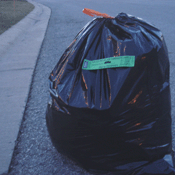Pay-As-You-Throw is a unit-based pricing system in which residents pay for the amount of waste discarded rather than paying a fixed residential fee. It is also known as Pay-Per-Use, Unit Based Pricing, or Variable Based Pricing.
1) Environmental Sustainability
2) Economic Sustainability
3) Equity
* From the E.P.A.
1) Saves Residents Money: Less Trash = Lower Cost.
2) Increases Recycling: Residents recycle more since it costs less than tossing out recyclable items.
3) Improves the Environment: More Recycling = Less Landfill Usage.
Pay as you throw programs vary from city to city and often are implemented by local governments or haulers. In some programs every item that is discarded requires a sticker. In other programs extra bag tags are used for items in excess of a set amount of trash.
Besides those types of programs, sometimes labels or bags are used for specific items such as bulk items (appliances, sofas), CRT items (Televisions and Monitors) and Yard Waste.

Example of a Refuse Based Sticker Program
Due to inexpensive scanners, digital cameras, and color printers, residents have discovered that standard refuse labels and yardwaste labels can be easily duplicated.

H.H.H. Incorporated's die-cut labels make it very difficult for label counterfeiters. The die-cut garbage truck shows through as white when it is scanned or copied. In addition, the crisp die-cut emblem gives drivers an easily identifiable shape so that counterfeit labels are immediately recognized.

How successful have H.H.H. Incorporated's die-cut PAYT Stickers been?
Haulers that have switched to H.H.H. Incorporated's die-cut labels have recorded increases in label sales by as much as 28% per year. Put another way, counterfeit labels were costing the hauler with the 28% counterfeit problem over $1 million in revenue each year. Can you afford not to use H.H.H. Incorporated's Counterfeit Deterrent Labels?

